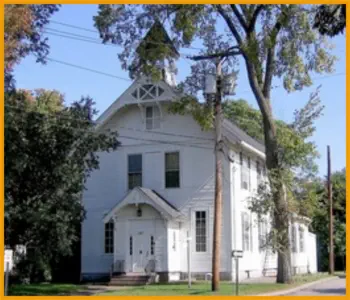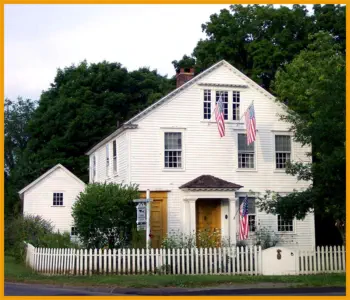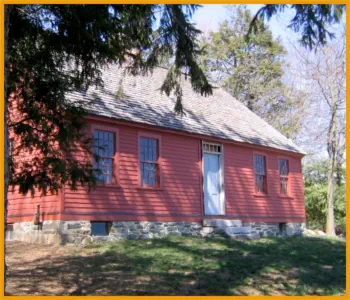



Orange Historical Society


Orange, Connecticut
History
History of Orange Public Schools (continued)
As
soon
as
the
Church
was
organized
in
1805,
the
members
of
the
town
established
the
North
Milford
School
Society
with
the
first
meeting
in
1806.
At
that
time,
there
were
three
distinct
districts
showing
that
the
original
208
acres
that
were
established
by
Richard
Bryan
in
1700
had
significantly
increased.
The
southern
part
of
the
town
was
called
the
First
District,
located
on
the
corner
of
South
Main
Street
(Orange
Center
Road)
and
Morse
Road
(Old
Tavern
Road).
The
Second
District,
to
the
north,
was
located
at
the
triangle
formed
by
Grassy
Hill
Road
(now
Old
Grassy
Hill)
and
Milford
Road
(Ridge
Road
today).
The
western
end
was
the
Third
District
with
its
location
at
the
corner
of
Clark
Lane
and
Race
Road
(Grassy
Hill
Road).
A
sum
of
$599
from
the
Milford
budget
was
allowed
for
the
expenses
for
the
year
with
a
committeeman
chosen
for
each
district
to
make
the
arrangements
for
the
teacher
and
to
secure
enough
firewood.
School
visitors
were chosen and given the responsibility to visit the schools and “pass judgment.” Ouch! Talk about the fox in the henhouse!
It
appears
that
no
special
preparation
was
necessary
to
qualify
as
a
teacher
in
the
beginning;
but
in
checking
the
names
of
the
various
teachers,
the
better-known
citizens
were
chosen.
One
such
educator,
Benjamin
Clark
(1814-1890)
was
remembered
by
a
student
as
being
a
generous-hearted, educated man having been thought of as the best he had by far.
With
increased
population
in
the
eastern
portion,
an
additional
district
was
formed
to
accommodate
what
was
known
as
the
Allingtown
section;
and
by
1882,
the
population
in
Milford
was
moving
closer
to
North
Milford,
so
the
citizens
requested
to
be
included
in
the
third
district.
The
First
remained
to
service
the
south,
the
second
covered
the
northwestern
part,
the
newly-formed
Allingtown
section
was
now
the
third,
and
what
had
been
the
third
was
the
fourth.
After
the
New
Haven
and
Derby
Railroad
was
established
in
1871,
the
Fifth
District
School
(Tyler
City)
was
established
in
1873
with
classes
being
held
in
one
of
the
waiting
rooms
of
the
Tyler
City
Station.
By
1874,
Samuel
Halliwell
and
Philander
Ferry,
partners
of
the
newly
formed
Tyler
City,
donated
land
for
a
building
to
be
constructed
between
what
is
now New Haven Avenue and Spring Street.
Today,
four
of
the
five
district
schools
are
still
standing
with
interesting
“new”
lives.
District
1
is
the
home
of
our
First
Selectman;
District
2
is
the
second
story
of
a
house
on
Ridge
Road;
District
3
is
on
the
corner
of
Racebrook
Road
and
Woodside
Avenue;
District
4
burned
down;
and
District
5
is
Our
Lady
of
Sorrows
Church.
There
is
an
adjacent
building
on
this
property
that
was
built
to
house
the
horses
and
carriages,
as
there
is
evidence
that
the
schools
were
also
used
for
religious
services.
Winter
school
began
in
the
middle
of
November
running
for
four
months
with
a
male
teacher;
summer
school,
beginning
in
April
for
six
months,
was
held
with
a
female
teacher.
The
teacher
was
supposed
to
be
boarded
with
the
inhabitants
throughout
the
district
taking
turns;
anyone
who
refused
was
taxed
at
the
rate
of
$1.25
per
week.
The
“school
rules”
did
not
mention
the
rod,
but
it
appears
that
it
was
available
to
be
used.
In
his
Orange
Historical
Collections,
Edward
Luke
Clark
writes
that
Charles
Wheeler,
hired
for
the
Third
District
in
1837,
whose
only
qualification
was
his
determination
to
preserve
order,
indeed
kept
a
supply
of
rods
for
that
purpose.
Mr.
Clark’s
uncle
was
the
recipient
of
the
thrashing
on
many occasions having “natural boyish propensities” and being disliked by Mr. Wheeler.
The
subjects
taught
at
our
district
schools
appear
to
follow
what
we
think
of
as
the
“old
school”
subjects
of
reading,
writing,
and
arithmetic
with
spelling,
grammar,
geography
and
history
to
round
out
the
day.
Each
morning
started
with
devotional
singing
of
at
least
eight
religiously-based
songs;
and
there
were
three
recess
times,
two
of
which
were
“whisper
recesses.”
The
afternoon
singing
was
secular
with
'The
Old
Oaken
Bucket'
a
favorite.
The
report
card
of
the
Orange
Center
School
in
1909-1910
shows
some
changes
in
the
curriculum,
but
not
in
“The
Rules.”
Careful
note
of
absences
and
tardies,
as
well
as
dismissals,
topped
the
card
with
conduct
the
next
in
line.
A
letter
system
was
used
with
E
90-100
(excellent),
G
80-89
(good),
F
70-79
(fair),
and
P
0-69
(poor).
The
card
was
issued
monthly
with
parents’
signature
on
the
back
with
the
note
saying,
“If
in
either
scholarship
or
deportment,
a
pupil
fails
to
receive
a
mark
as
high
as
F
or
70,
he
is
in danger of losing his place in school.
Although
history
and
nature
study
are
listed,
we
have
a
report
card,
in
the
archives
of
the
OHS,
that
doesn’t
have
any
grades
for
those
subjects
marked
for
the
entire
year
and
with
geography
being
given
a
mark
in
only
five
of
the
nine
months.
Of
the
school
year,
excluding
September, arithmetic, drawing, language/grammar, music, reading, spelling, writing, and effort were considered the requirements.
The
School
Society
itself
had
a
myriad
of
responsibilities
in
addition
to
the
education
of
its
young
people.
In
1836
it
voted
to
repair
the
fence
at
the
burying
ground
and
to
purchase
a
hearse;
and
in
1855,
the
Society
voted
to
buy
a
new
hearse,
selling
the
old
one.
They
also
voted to pay Benjamin Clark $120 to expand the cemetery, but this vote was later rescinded and the land was bought by the town.
So
goes
the
history
of
the
“Little
Red
School”
houses,
though
according
to
the
History
of
Orange,
the
school
houses
were
always
painted
white.
Note: The History of Orange 1639-1949 is available at the Town Hall Town Clerk’s office













Bryan Andrew









Orange Historical Society
Orange, Connecticut








Bryan Andrew





History
History of Orange Public
Schools (continued)
It
appears
that
no
special
preparation
was
necessary
to
qualify
as
a
teacher
in
the
beginning;
but
in
checking
the
names
of
the
various
teachers,
the
better-known
citizens
were
chosen.
One
such
educator,
Benjamin
Clark
(1814-
1890)
was
remembered
by
a
student
as
being
a
generous-
hearted,
educated
man
having
been
thought
of
as
the
best
he had by far.
With
increased
population
in
the
eastern
portion,
an
additional
district
was
formed
to
accommodate
what
was
known
as
the
Allingtown
section;
and
by
1882,
the
population
in
Milford
was
moving
closer
to
North
Milford,
so
the
citizens
requested
to
be
included
in
the
third
district.
The
First
remained
to
service
the
south,
the
second
covered
the
northwestern
part,
the
newly-formed
Allingtown
section
was
now
the
third,
and
what
had
been
the
third
was
the
fourth.
After
the
New
Haven
and
Derby
Railroad
was
established
in
1871,
the
Fifth
District
School
(Tyler
City)
was
established
in
1873
with
classes
being
held
in
one
of
the
waiting
rooms
of
the
Tyler
City
Station.
By
1874,
Samuel
Halliwell
and
Philander
Ferry,
partners
of
the
newly
formed
Tyler
City,
donated
land
for
a
building
to
be
constructed
between
what
is
now
New
Haven
Avenue
and
Spring Street.
Today,
four
of
the
five
district
schools
are
still
standing
with
interesting
“new”
lives.
District
1
is
the
home
of
our
First
Selectman;
District
2
is
the
second
story
of
a
house
on
Ridge
Road;
District
3
is
on
the
corner
of
Racebrook
Road
and
Woodside
Avenue;
District
4
burned
down;
and
District
5
is
Our
Lady
of
Sorrows
Church.
There
is
an
adjacent
building
on
this
property
that
was
built
to
house
the
horses
and
carriages,
as
there
is
evidence
that
the
schools
were
also
used
for
religious
services.
Winter
school
began
in
the
middle
of
November
running
for
four
months
with
a
male
teacher;
summer
school,
beginning
in
April
for
six
months,
was
held
with
a
female
teacher.
The
teacher
was
supposed
to
be
boarded
with
the
inhabitants
throughout
the
district
taking
turns;
anyone
who
refused
was
taxed
at
the
rate
of
$1.25
per
week.
The
“school
rules”
did
not
mention
the
rod,
but
it
appears
that
it
was
available
to
be
used.
In
his
Orange
Historical
Collections,
Edward
Luke
Clark
writes
that
Charles
Wheeler,
hired
for
the
Third
District
in
1837,
whose
only
qualification
was
his
determination
to
preserve
order,
indeed
kept
a
supply
of
rods
for
that
purpose.
Mr.
Clark’s
uncle
was
the
recipient
of
the
thrashing
on
many
occasions
having
“natural
boyish
propensities” and being disliked by Mr. Wheeler.
The
subjects
taught
at
our
district
schools
appear
to
follow
what
we
think
of
as
the
“old
school”
subjects
of
reading,
writing,
and
arithmetic
with
spelling,
grammar,
geography
and
history
to
round
out
the
day.
Each
morning
started
with
devotional
singing
of
at
least
eight
religiously-based
songs;
and
there
were
three
recess
times,
two
of
which
were
“whisper
recesses.”
The
afternoon
singing
was
secular
with
'The
Old
Oaken
Bucket'
a
favorite.
The
report
card
of
the
Orange
Center
School
in
1909-1910
shows
some
changes
in
the
curriculum,
but
not
in
“The
Rules.”
Careful
note
of
absences
and
tardies,
as
well
as
dismissals,
topped
the
card
with
conduct
the
next
in
line.
A
letter
system
was
used
with
E
90-100
(excellent),
G
80-89
(good),
F
70-79
(fair),
and
P
0-69
(poor).
The
card
was
issued
monthly
with
parents’
signature
on
the
back
with
the
note
saying,
“If
in
either
scholarship
or
deportment,
a
pupil
fails
to
receive
a
mark
as
high
as
F
or
70,
he
is
in
danger
of
losing
his
place
in school.
Although
history
and
nature
study
are
listed,
we
have
a
report
card,
in
the
archives
of
the
OHS,
that
doesn’t
have
any
grades
for
those
subjects
marked
for
the
entire
year
and
with
geography
being
given
a
mark
in
only
five
of
the
nine
months.
Of
the
school
year,
excluding
September,
arithmetic,
drawing,
language/grammar,
music,
reading,
spelling,
writing,
and
effort
were
considered
the
requirements.
The
School
Society
itself
had
a
myriad
of
responsibilities
in
addition
to
the
education
of
its
young
people.
In
1836
it
voted
to
repair
the
fence
at
the
burying
ground
and
to
purchase
a
hearse;
and
in
1855,
the
Society
voted
to
buy
a
new
hearse,
selling
the
old
one.
They
also
voted
to
pay
Benjamin
Clark
$120
to
expand
the
cemetery,
but
this
vote
was later rescinded and the land was bought by the town.
So
goes
the
history
of
the
“Little
Red
School”
houses,
though
according
to
the
History
of
Orange,
the
school
houses were always painted white.
Note:
The
History
of
Orange
1639-1949
is
available
at
the
Town Hall Town Clerk’s office













































































































































